Spinach is one of the most nutrient-dense leafy greens, supporting heart, bone, eye, and immune health naturally. Packed with vitamins, minerals, and powerful antioxidants, spinach may help protect the body from oxidative stress and promote overall wellness. Understanding its benefits can help you make the most of this everyday superfood — whether you eat it raw, cooked, or blended into smoothies.
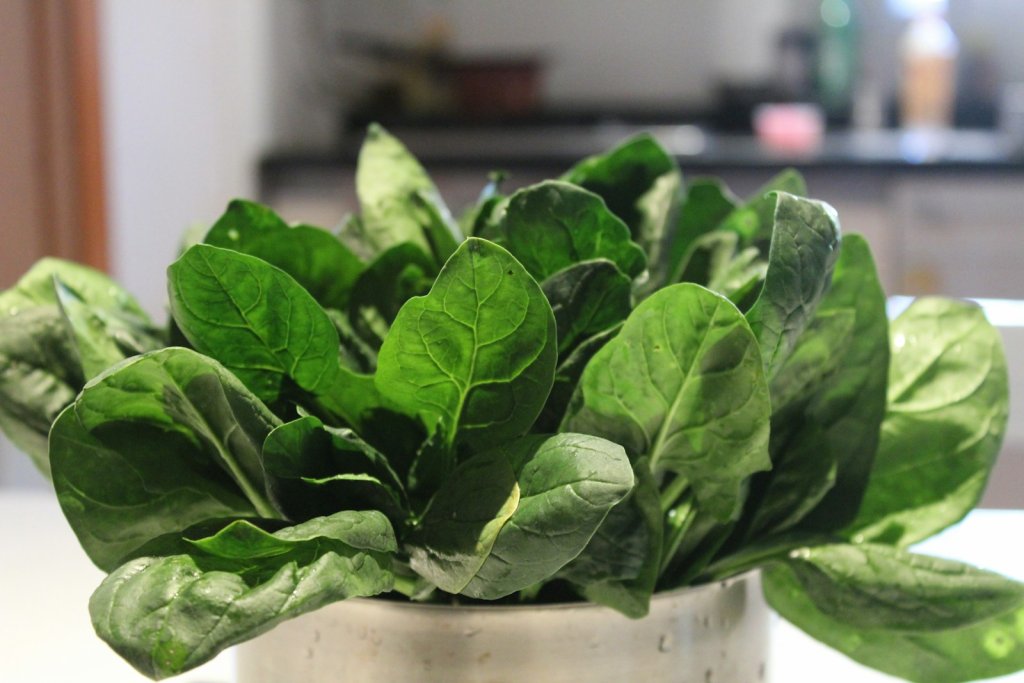
What Makes Spinach So Healthy? (Overview & Nutrition Profile)
Spinach (Spinacia oleracea) is one of the most nutrient-dense leafy greens available — low in calories yet packed with essential vitamins, minerals, and plant compounds that promote overall wellness. This combination makes it a foundational food for heart, bone, eye, and immune health.
According to USDA FoodData Central (2024), one cup (30 grams) of raw spinach provides:
| Nutrient | Amount | % Daily Value (DV) |
|---|---|---|
| Calories | 7 kcal | — |
| Vitamin A (as beta-carotene) | 2,813 IU | 56% |
| Vitamin K | 145 µg | 121% |
| Folate (Vitamin B9) | 58 µg | 15% |
| Vitamin C | 8.4 mg | 14% |
| Iron | 0.8 mg | 5% |
| Magnesium | 24 mg | 6% |
| Potassium | 167 mg | 5% |
| Calcium | 30 mg | 3% |
| Fiber | 0.7 g | — |
(Source: USDA FoodData Central – Spinach, Raw (2024))
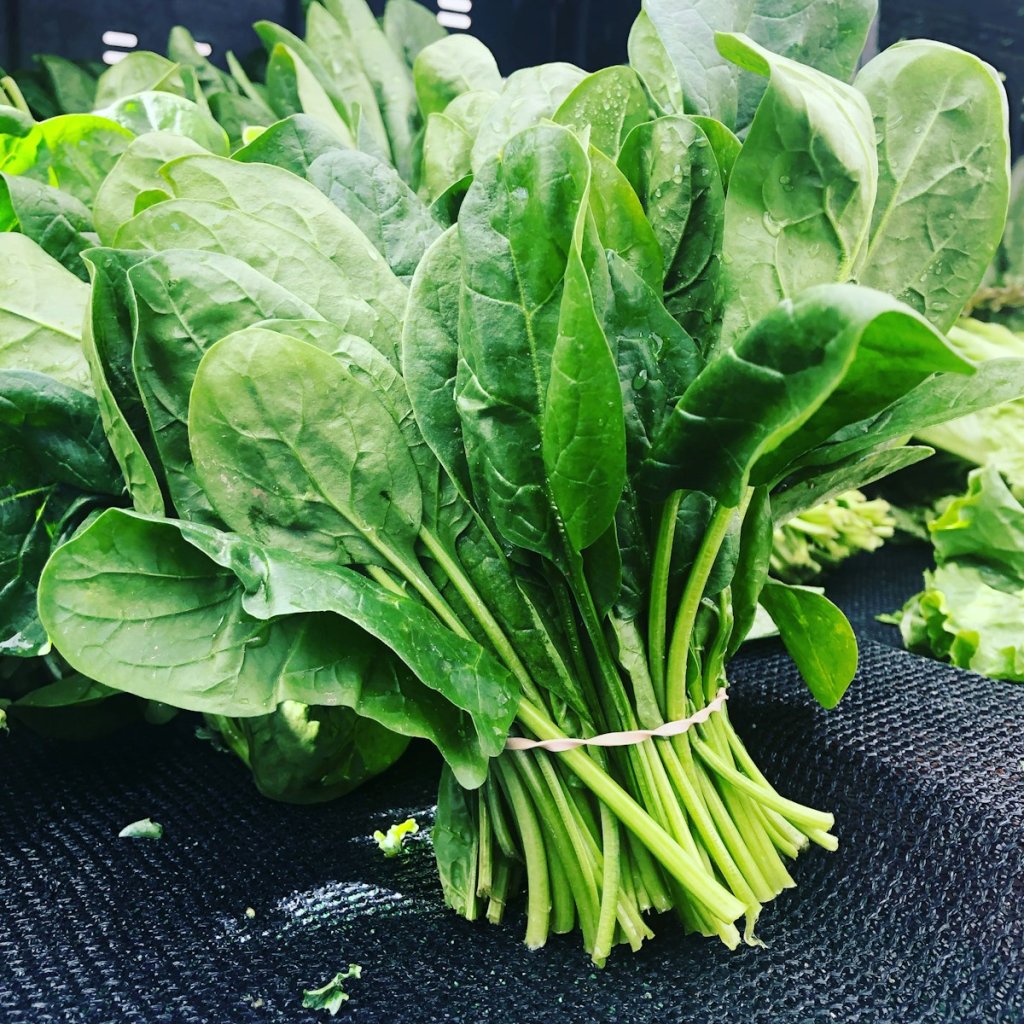
Spinach’s impressive nutrient profile provides powerful antioxidants (like lutein, zeaxanthin, and quercetin), plant nitrates that support heart health, and phytonutrients that combat oxidative stress. These compounds work synergistically to protect cells, support metabolism, and promote longevity.
Because spinach is rich in water and fiber but very low in calories, it’s also excellent for hydration, digestion, and weight management — making it one of the most versatile and beneficial vegetables in a balanced diet.
For more information on the nutritional importance of leafy greens, visit Harvard T.H. Chan School of Public Health – Vegetables and Health.
10 Proven Health Benefits of Spinach (Science-Based)
1. Supports Heart Health
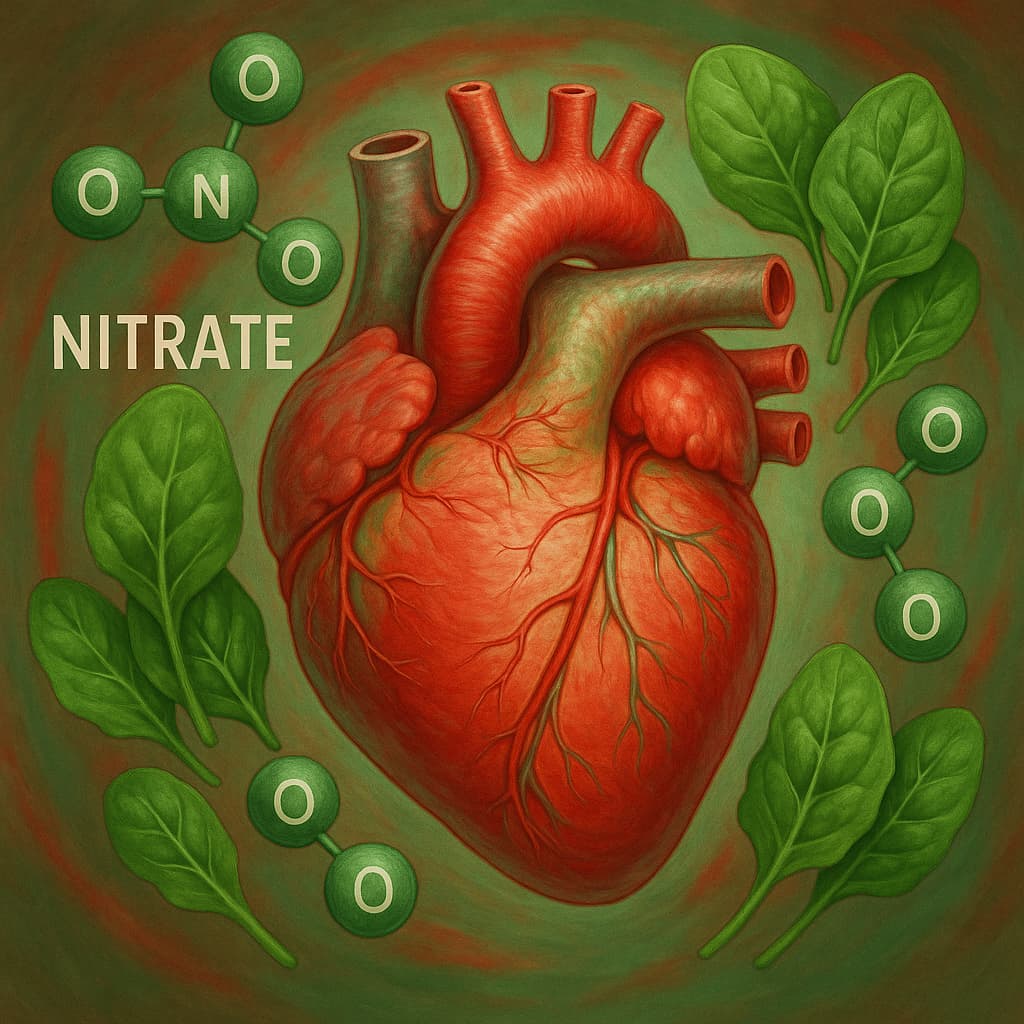
Spinach is naturally rich in dietary nitrates, compounds the body converts into nitric oxide — a molecule that relaxes and widens blood vessels, promoting smoother circulation and healthier blood pressure levels. This vasodilating effect supports overall cardiovascular wellness by helping arteries remain flexible and reducing strain on the heart.
According to Harvard Health Publishing (2024), leafy green vegetables like spinach are among the most effective foods for protecting heart health. They provide potassium, magnesium, and antioxidants that help maintain normal blood pressure and reduce oxidative stress in the arteries. Regular consumption of greens has been linked with a 12–26% lower risk of cardiovascular disease in long-term studies.
→ Reference: Harvard Health Publishing – Heart-Healthy Foods: What to Eat and What to Avoid
Key nutrients: Nitrates, potassium, magnesium, vitamin C
Tip: Add lightly steamed spinach to soups, grain bowls, or omelets. Pair it with vitamin-C-rich foods like lemon juice or bell peppers to enhance the body’s nitric-oxide production and blood vessel health.
By making spinach a regular part of your meals, you’re giving your heart a natural boost — supported by science and leading health authorities.
2. Promotes Eye Health
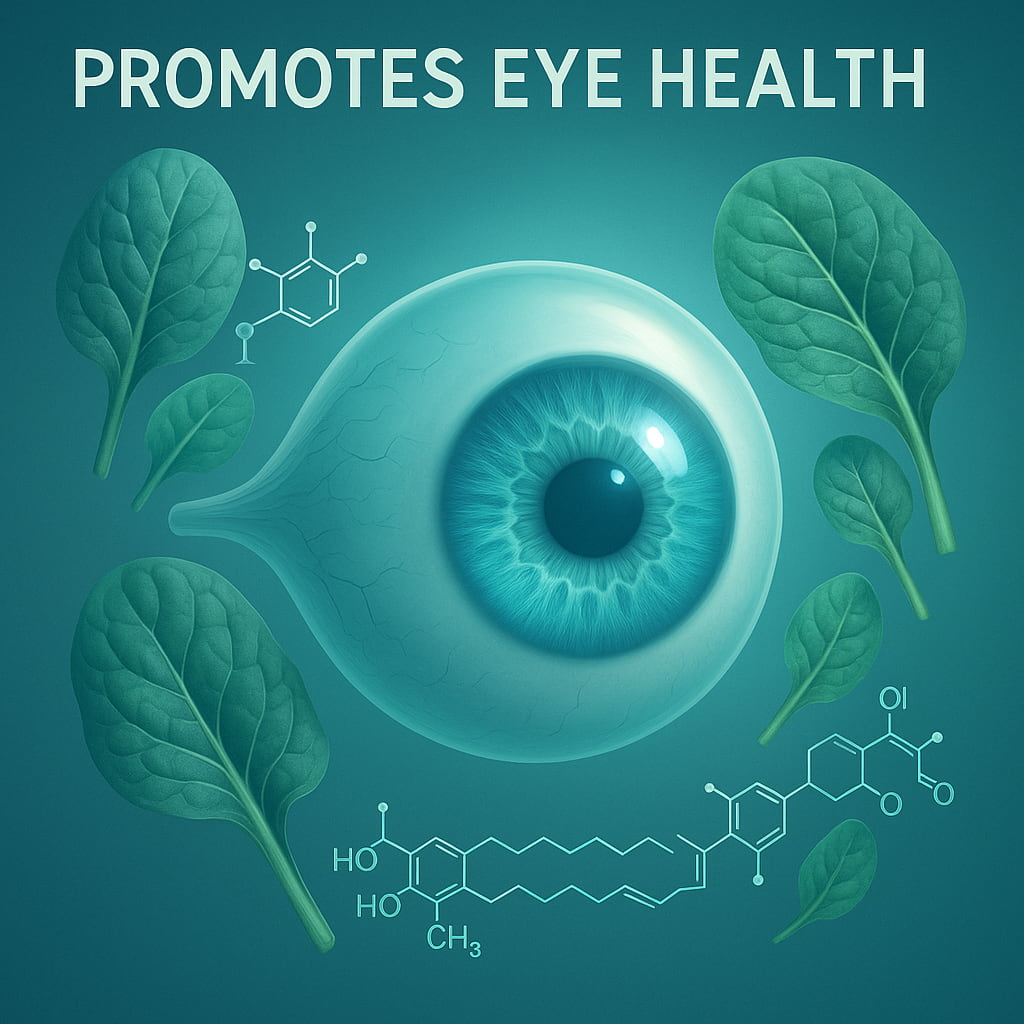
Spinach is packed with lutein and zeaxanthin, carotenoids that accumulate in the retina and filter harmful blue light. These antioxidants help maintain clear vision and may reduce risk of age-related macular degeneration (AMD).
The American Optometric Association notes that diets rich in these pigments support long-term retinal health.
Key nutrients: Lutein, zeaxanthin, vitamin A
Tip: Pair spinach with olive oil or avocado — both help your body absorb fat-soluble carotenoids more effectively.
Learn more at the AOA Eye Health and Nutrition page.
3. Strengthens Bones and Teeth
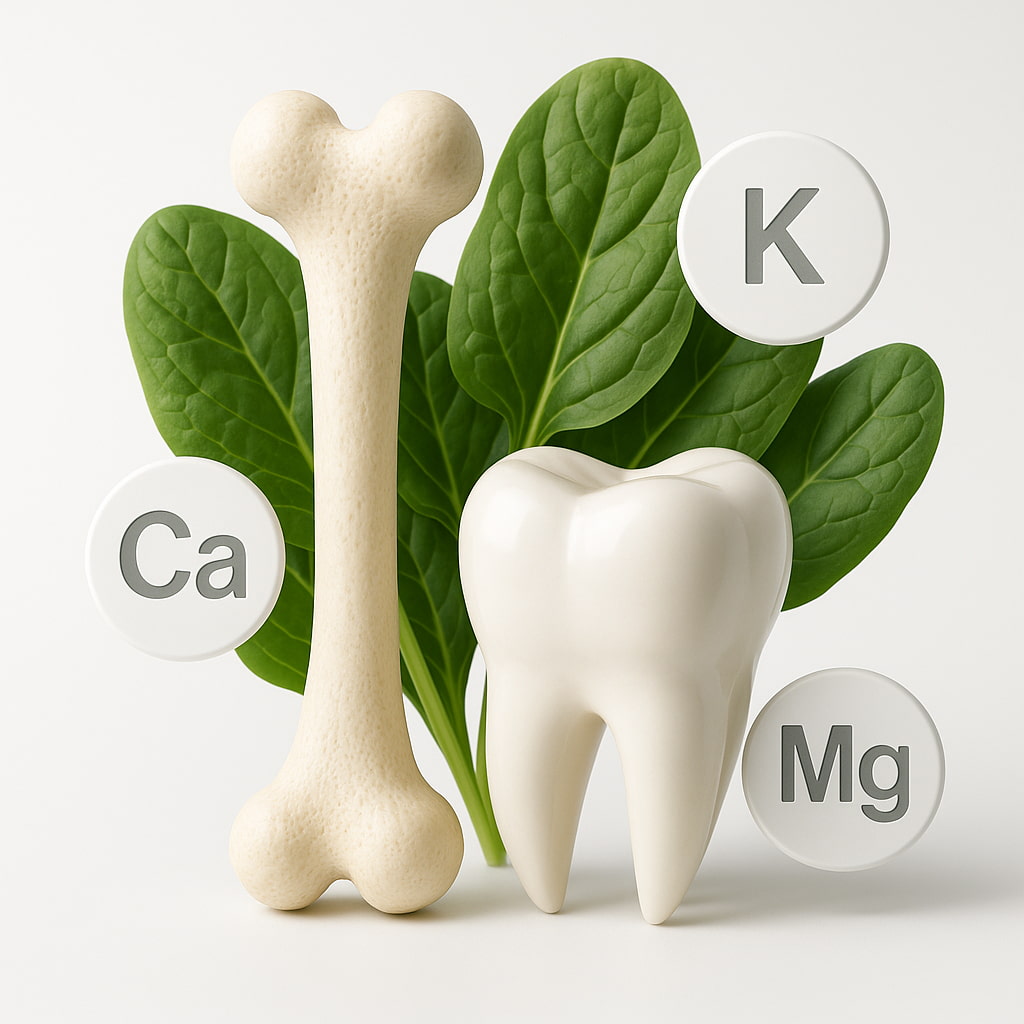
Spinach provides vitamin K, calcium, and magnesium, all of which work together to build and maintain strong bones. Vitamin K activates osteocalcin, a protein that binds calcium in bone tissue and keeps bones structurally sound.
According to the National Institutes of Health (2024), adequate vitamin K intake supports bone density and reduces fracture risk in older adults.
Key nutrients: Vitamin K, calcium, magnesium
Tip: Eat cooked spinach — its reduced volume delivers a higher nutrient density per serving. Rotate greens (like kale or collards) for balance.
4. Enhances Brain and Cognitive Function
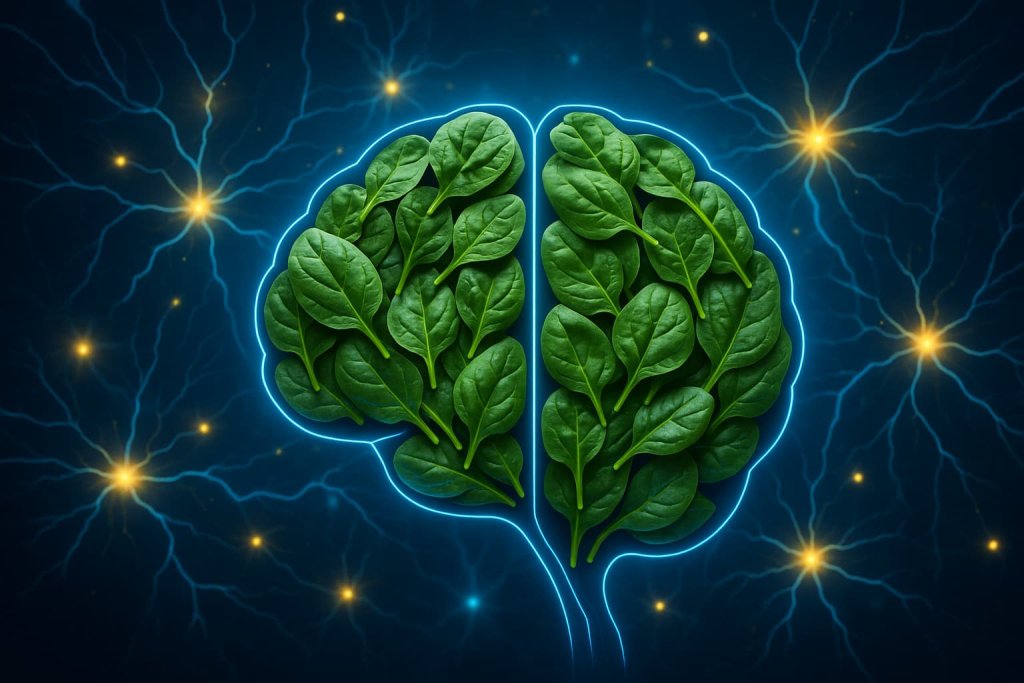
Spinach’s mix of folate, vitamin K, and antioxidants nourishes neurons and supports communication between brain cells. These nutrients help protect the brain from oxidative stress and support normal cognitive processing.
A Neurology study found that older adults who ate leafy greens daily showed cognitive performance equivalent to being 11 years younger than peers who rarely ate them.
Key nutrients: Folate, vitamin K, lutein
Tip: Blend spinach into a morning smoothie with berries for brain-supportive antioxidants and natural sweetness.
5. Helps Manage Blood Sugar Levels
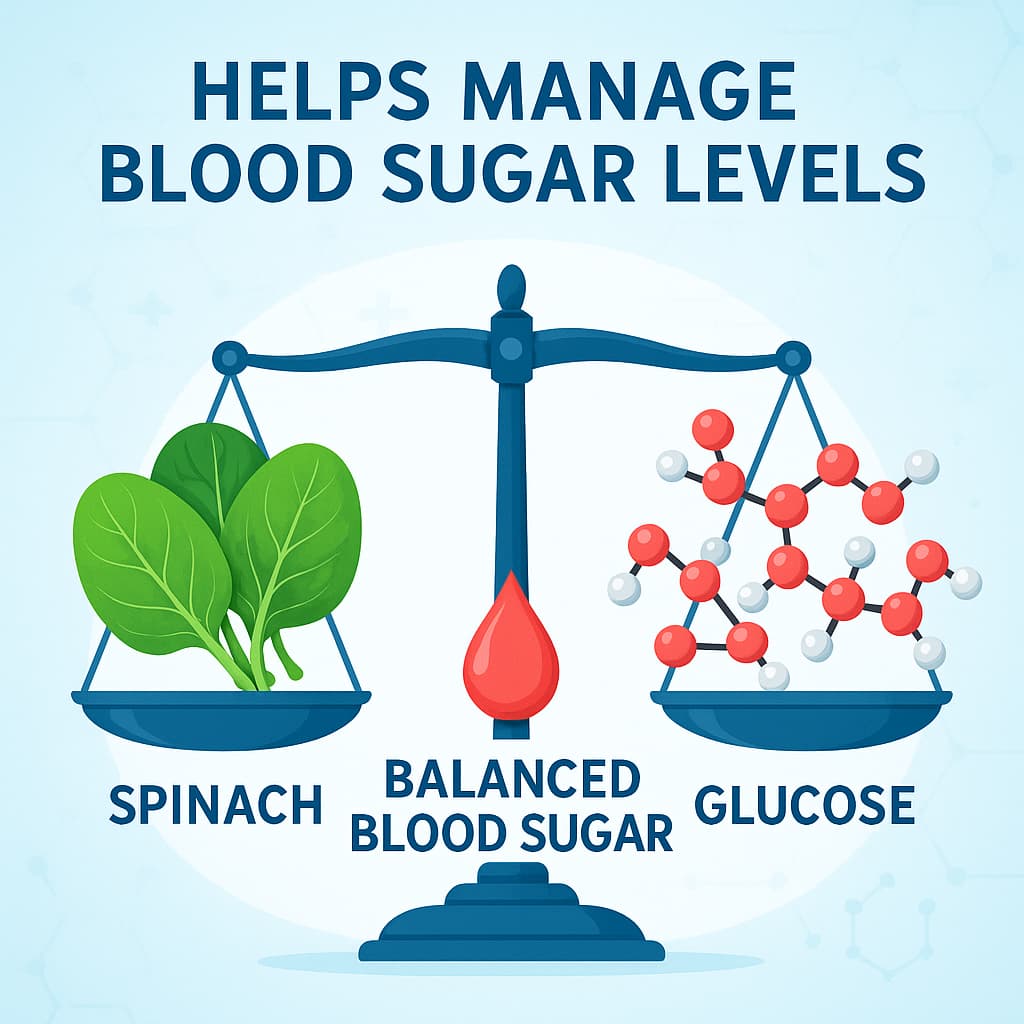
Spinach is low in carbohydrates and contains magnesium and fiber, both of which help stabilize blood sugar and improve insulin sensitivity. Magnesium plays a direct role in glucose metabolism and energy production.
A 2023 Nutrients review reported that people who regularly eat magnesium-rich vegetables like spinach have better glucose control and lower risk of insulin resistance.
Key nutrients: Magnesium, fiber, antioxidants
Tip: Build meals combining spinach with lean protein (fish, tofu) and complex carbs (brown rice, quinoa) for balanced energy.
6. Supports Healthy Skin and Hair

Spinach is loaded with vitamins A, C, and E, which play vital roles in maintaining radiant skin and strong, healthy hair. Vitamin A supports normal skin cell turnover, helping repair tissues and prevent dryness. Vitamin C boosts collagen synthesis, keeping skin firm and elastic while also improving iron absorption for better blood circulation to hair follicles. Vitamin E, a powerful antioxidant, helps shield skin from UV damage and environmental pollutants, reducing oxidative stress that accelerates aging.
In addition, spinach provides iron, which delivers oxygen to cells and supports hair growth and scalp nourishment — a key factor in preventing hair thinning.
According to the Cleveland Clinic (2024), nutrient-dense foods like spinach that are rich in vitamins A, C, and E help keep the skin hydrated, protect against inflammation, and promote a natural glow.
→ Reference: Cleveland Clinic – 23 Foods That Are Good for Your Skin
Key nutrients: Vitamin A, Vitamin C, Vitamin E, Iron
Tip: Blend spinach into fruit smoothies with oranges, strawberries, or kiwi to maximize vitamin C absorption and enhance its skin-supporting benefits.
Regularly adding spinach to your meals supports your skin and hair from within — promoting a clear complexion, stronger hair, and overall healthy appearance, backed by science and dermatologist-approved nutrition insights.
7. Boosts Immune System Function
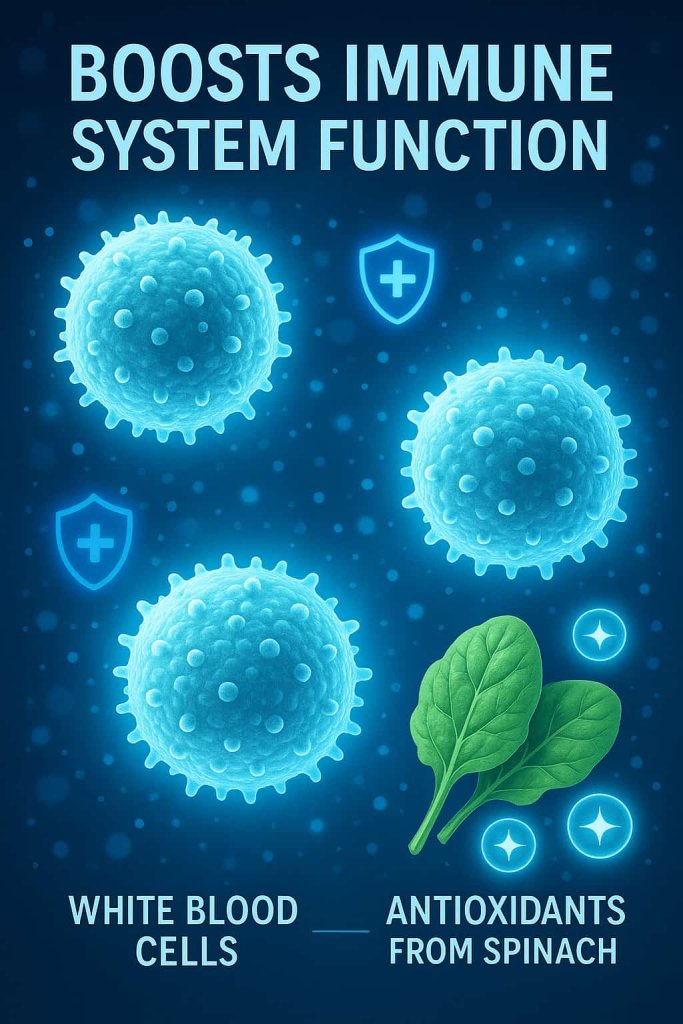
Spinach is an excellent source of vitamin C, beta-carotene, and iron — nutrients that play a central role in maintaining a strong and balanced immune system. Vitamin C enhances the production and function of white blood cells, helping your body fight infections effectively. Beta-carotene, which the body converts into vitamin A, supports healthy mucous membranes — your first line of defense against pathogens. Meanwhile, iron ensures proper oxygen transport, fueling immune cell activity throughout the body.
According to the Cleveland Clinic (2024), a diet rich in fruits and vegetables like spinach provides antioxidants that help reduce inflammation, strengthen immune defenses, and improve recovery from illness. Regular intake of leafy greens supports the body’s natural ability to protect itself from infections and oxidative stress.
→ Reference: Cleveland Clinic – 12 Foods to Boost Your Immune System
Key nutrients: Vitamin C, beta-carotene, iron
Tip: Enjoy spinach raw in salads or lightly steamed to preserve its vitamin C content. Pair it with citrus fruits, tomatoes, or bell peppers to enhance nutrient absorption and immune benefits.
8. Aids in Weight Management

Spinach is a nutrient-dense yet very low-calorie food, providing only about 7 calories per cup of raw leaves. Its combination of fiber, water, and thylakoids (natural plant membranes found in spinach leaves) helps promote satiety and reduce hunger between meals. Fiber slows digestion and stabilizes blood sugar levels, while thylakoids have been shown to influence appetite-regulating hormones — helping people feel full longer and avoid overeating.
A 2022 review in Nutrition Research found that participants who consumed spinach extracts experienced improved satiety and reduced cravings after meals. Similarly, Harvard Health Publishing (2024) notes that increasing vegetable intake — particularly leafy greens — is one of the most effective strategies for weight control because they add volume and nutrients without excess calories.
→ Reference: Harvard Health – Diet and Weight Loss: Healthy Eating for Weight Control
Key nutrients: Fiber, thylakoids, plant protein
Tip: Add a handful of spinach to smoothies, wraps, or soups to enhance fullness and nutrient density. Pair it with protein-rich foods like eggs, lentils, or yogurt to promote sustained energy and appetite balance.
9. May Support Liver and Detox Functions
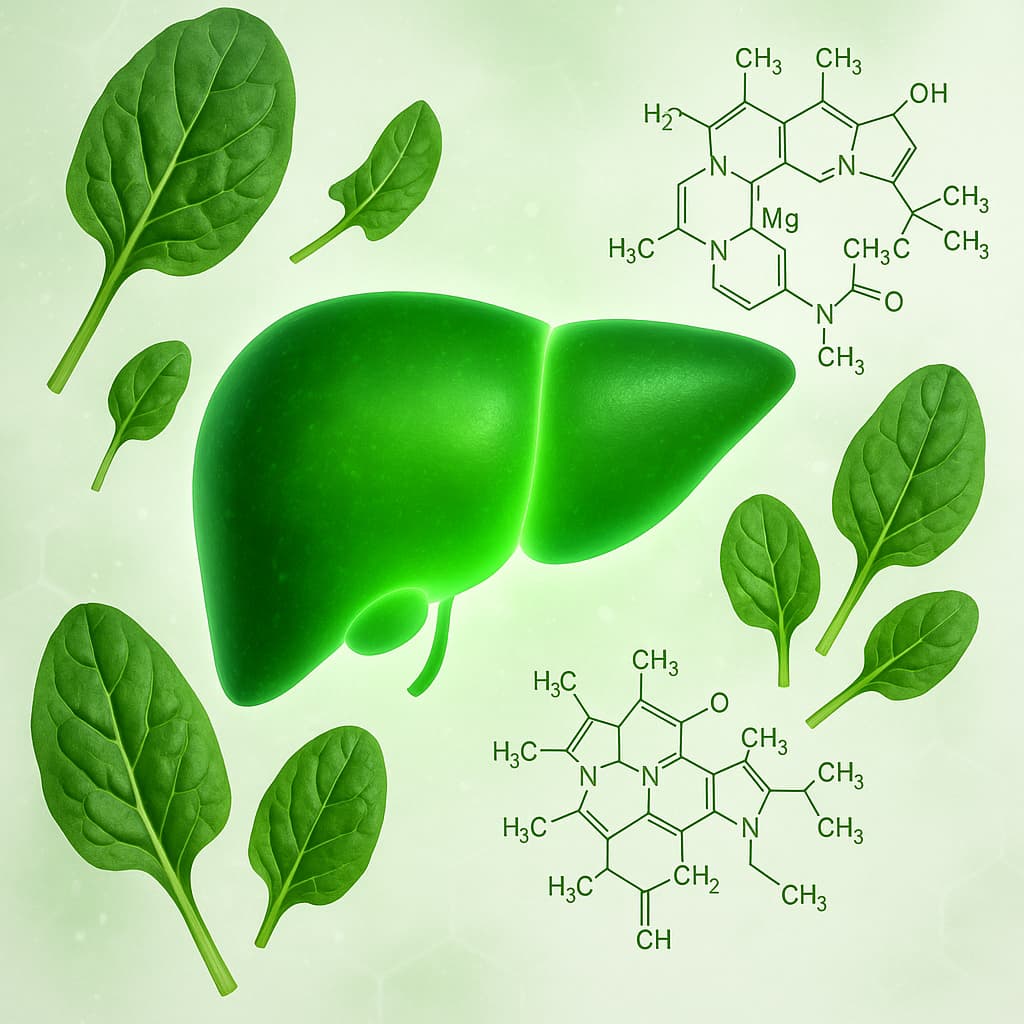
Spinach contains chlorophyll, polyphenols, and antioxidants that naturally support the liver’s detoxification processes. These compounds help neutralize harmful free radicals, reduce oxidative stress, and promote healthy liver enzyme activity — all of which contribute to better metabolic balance.
While many “detox” diets claim to cleanse the liver, medical experts clarify that the liver already detoxifies itself. What truly supports liver function is a diet rich in leafy greens, fruits, and whole plant foods. According to Harvard Health Publishing (2024), nutrient-dense vegetables like spinach — combined with proper hydration and limited alcohol intake — help the liver metabolize fats efficiently and maintain long-term health.
→ Reference: Harvard Health – The Skinny on Fatty Liver: How to Reverse It Naturally
Key nutrients: Chlorophyll, polyphenols, antioxidants
Tip: Blend spinach with lemon, apple, or cucumber for a refreshing smoothie that supports natural detox pathways. The vitamin C from citrus enhances antioxidant defense while spinach provides fiber and phytonutrients for liver wellness.
Adding spinach to your meals consistently — rather than relying on short-term “cleanses” — is a safe, evidence-based way to nourish your liver and promote long-term vitality.
10. May Reduce Inflammation and Oxidative Stress
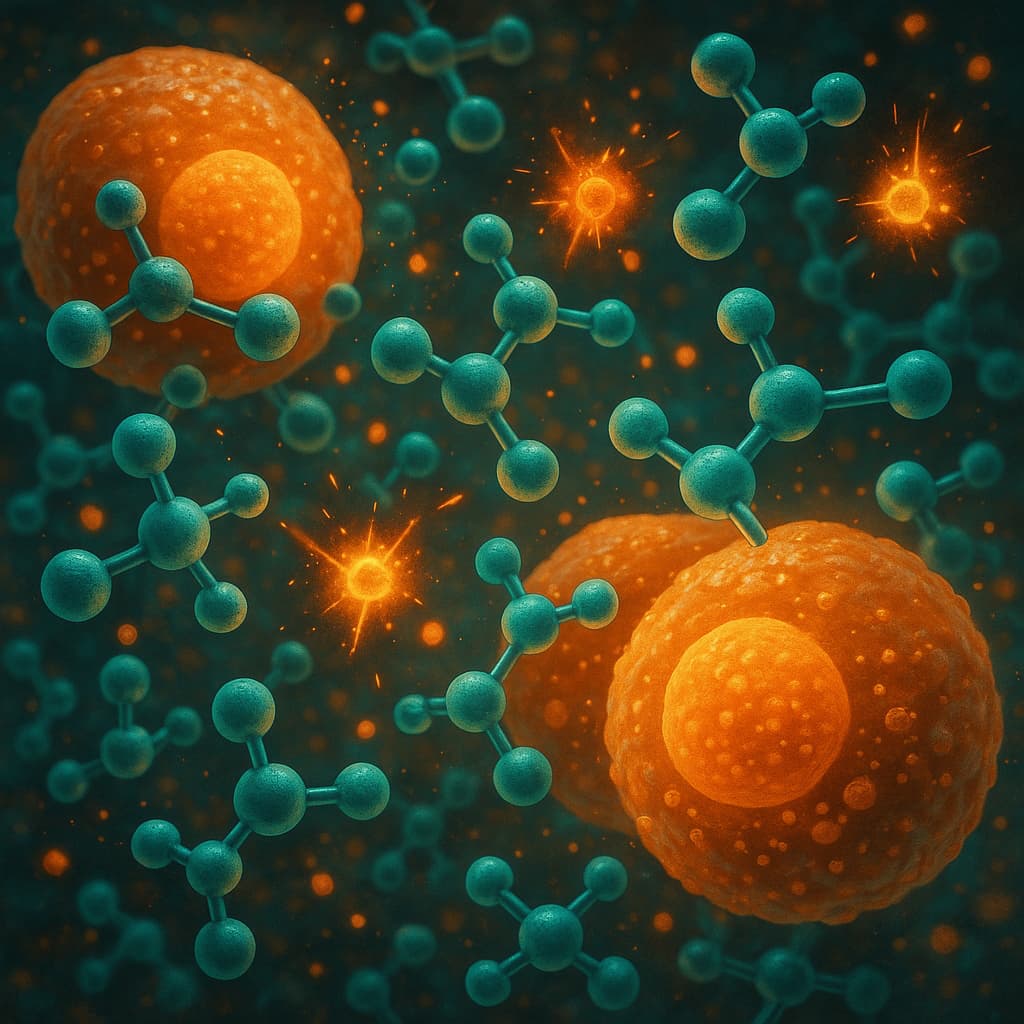
Spinach provides powerful flavonoids (quercetin, kaempferol) and antioxidant vitamins C and E that help neutralize harmful free radicals. Chronic oxidative stress is linked to many conditions, and antioxidant-rich foods can support the body’s natural defense.
Recent reviews in Frontiers in Nutrition describe these compounds’ role in reducing cellular inflammation and supporting overall wellness.
Key nutrients: Flavonoids, vitamin E, vitamin C
Tip: Combine spinach with colorful vegetables (like bell pepper or carrots) to broaden antioxidant coverage.
Possible Side Effects and Precautions
Although spinach is a powerhouse of nutrition, it’s important to be aware of a few safety considerations — especially if you have certain medical conditions or dietary restrictions. This section ensures balance and factual accuracy for health-related topics in compliance with Google’s YMYL (Your Money or Your Life) standards.
| Risk | Description | Guidance |
|---|---|---|
| Oxalates | Spinach is naturally high in oxalic acid, a compound that can bind to calcium and may contribute to kidney stone formation in sensitive individuals. | Drink plenty of water and rotate greens (e.g., kale, arugula) to reduce oxalate exposure. Those with a history of kidney stones should consult a healthcare provider. |
| Vitamin K Interaction | Spinach is very high in vitamin K, which plays a key role in blood clotting. However, this can interfere with blood-thinning medications such as warfarin. | Maintain a consistent intake of vitamin K rather than avoiding it completely. Always check with your doctor before making dietary changes. (NIH – Vitamin K Fact Sheet) |
| Pesticide Residue | Spinach frequently ranks near the top of the Environmental Working Group’s “Dirty Dozen” list due to pesticide residue. | Wash thoroughly under running water, or choose organic spinach when possible. (FDA – Produce Safety Guidance) |
Key Takeaway:
Spinach is safe and beneficial for most people, but moderation and proper preparation help maximize its health benefits while minimizing potential risks.
How to Eat Spinach for Best Results
Knowing how to include spinach in your diet is just as important as knowing why it’s beneficial. These evidence-based tips help you use spinach safely and effectively as part of a balanced, nutrient-rich diet.
Ideal Daily Portion:
- 1–2 cups of raw spinach or about ½ cup cooked daily provides ample nutrients for most adults.
Best Forms:
- Raw: Perfect for salads, smoothies, or wraps — retains vitamin C and folate.
- Lightly steamed or sautéed: Increases the absorption of carotenoids and reduces oxalates.
- Blended: Works well in smoothies or soups for quick nutrient delivery.
Pairings for Maximum Absorption:
- Combine with healthy fats (olive oil, avocado, nuts) to enhance absorption of fat-soluble vitamins A, E, and K.
- Add vitamin-C-rich foods (lemon, bell peppers, citrus) to improve iron absorption.
Storage & Food-Safety Tips:
- Store fresh spinach in a refrigerator at or below 40°F (4°C) and consume within 5 days.
- Wash thoroughly before eating to remove dirt and possible pesticide residue.
- Avoid keeping cooked spinach at room temperature for more than 2 hours.
Key Takeaway:
Enjoy spinach in a variety of ways — both raw and cooked — to benefit from its full spectrum of nutrients. Pair it with healthy fats and vitamin-C sources for optimal absorption and always handle it safely.
Frequently Asked Questions (FAQs)
1. Can I eat spinach every day?
Yes, moderate daily intake (1–2 cups raw or ½ cup cooked) is safe and beneficial for most people. Rotate greens occasionally to diversify nutrient intake.
2. Is raw or cooked spinach healthier?
Both forms are beneficial — raw spinach preserves vitamin C, while cooked spinach improves the absorption of lutein, calcium, and iron.
3. Can spinach help with anemia?
Spinach contains non-heme iron, which supports iron intake. Pair it with vitamin-C-rich foods to enhance absorption.
4. Should people with kidney stones avoid spinach?
Individuals prone to oxalate stones should limit high-oxalate foods like spinach and drink plenty of water. Consult a healthcare professional for personalized advice.
5. Is spinach safe during pregnancy?
Yes — spinach provides folate and iron, which are important for fetal development. Wash thoroughly and consume moderate amounts as part of a balanced diet.
6. Can spinach interact with medications?
Yes — especially blood thinners like warfarin due to its high vitamin K content. Discuss your intake with your healthcare provider.
7. How can I make spinach taste better?
Combine it with flavorful ingredients like garlic, lemon, olive oil, or a sprinkle of parmesan for a healthy, tasty meal.
Conclusion
Spinach is one of the most nutrient-dense foods available — supporting your heart, bones, brain, eyes, and immune system with every serving. By adding it regularly to meals and following safe preparation practices, you can maximize its proven health benefits while minimizing potential risks.
Include spinach in your daily diet through salads, soups, smoothies, or sautéed dishes — and pair it with vitamin-C-rich and healthy-fat foods for better nutrient absorption.
This content is for informational purposes only and not medical advice.
References
- USDA FoodData Central – Spinach, Raw (Nutrition Profile)
Provides verified data on spinach’s calorie count, vitamins, minerals, and macronutrient composition. - Harvard Health Publishing – Heart-Healthy Foods: What to Eat and What to Avoid
Details how leafy greens like spinach support heart health, blood pressure, and overall cardiovascular function. - Harvard Health Publishing – The Skinny on Fatty Liver
Discusses how nutrient-rich vegetables like spinach support liver health and metabolism, without the need for “detox cleanses.” - FDA – Selecting and Serving Produce Safely
Official U.S. guidance on safe washing, storage, and preparation of spinach and other produce to minimize pesticide exposure.
